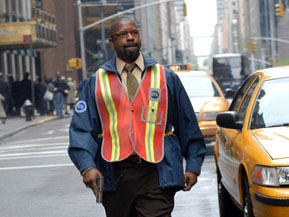Book vs. Movie
The Taking of Pelham 123
By Russ Bickerstaff
June 15, 2009
Freedgood/Godey takes an unflinchingly morbid and pessimistic look into the nature of society by looking at the same crime from multiple different perspectives. One character's assertion that no one is innocent seems to be coming quite directly from Freedgood/Godey himself as every character, no matter what his or her stature, turns out to have something to hide. There are no heroes here - only people. While this is far from the first work of fiction to ever take this perspective on human nature, it should be noted that works of fiction with very simplistic perceptions of good and evil (last summer's Dark Knight) still manage to become popular while being almost universally praised by critics. This kind of unflinchingly dark look at the people of New York, and by extension, people in general, is still pretty far ahead of its time.
The early 1970s New York described in the book is one where racial, ethnic and socio-economic tensions threaten to tear society apart from the ground up. There doesn't seem to be a character in the novel who isn't racist in some way, but all is not completely lost. There seem to be those who at least want to make things better for everyone and it's that virtue that rests at the heart of those characters in the novel who ultimately come off as being somewhat heroic. The novel does have a positive ending, (crime doesn't pay...the criminals don't get away thanks to the valiant efforts of a few men who prove to be good people after all) but it's clear that there is something fundamentally wrong with society. This is a novel where a few nameless, freed passengers from some of the train's cars end up making it to safety only to gang rape a 14 year-old black girl in a public restroom. The author throws that sort of thing in as a minor detail at the end of a paragraph. . . imagine that sort of detail being thrown-in at the end of the big hostage scene in The Dark Knight. That would've been dark . . .
Beyond the darkness, the author's storytelling style has clever pacing and formatting. Each chapter is subdivided into sections take from the perspectives of individual characters, which not only serves to give the kind of sweeping feel of seeing a story from every important perspective, but also allows the author some rather clever slight of hand with some of the plot elements. (One of the most interesting bits here happens when an off-duty police officer on the train is nearly detected by the hijackers. It's one of the author's more memorably original moments...)
The First Movie
The original 1974 film adaptation of The Taking of Pelham One Two Three has a very authentic vintage early ‘70s New York feel to it that is nonetheless quite entertaining to those of us who aren't big fans of that era in film.) Filmed almost entirely on location in New York, the 1974 film has plenty of vintage footage of New York in the early ‘70s that firmly establishes the film in the era the book was written in. Some of this has unintended consequences for a modern audience. In a particularly eerie moment, an actor playing the commissioner of police is found discussing the hostage situation in the back seat of a car...over his left shoulder in the window behind them the twin towers of the world trade center can clearly be seen...
Continued:
1
2
3
4
5




